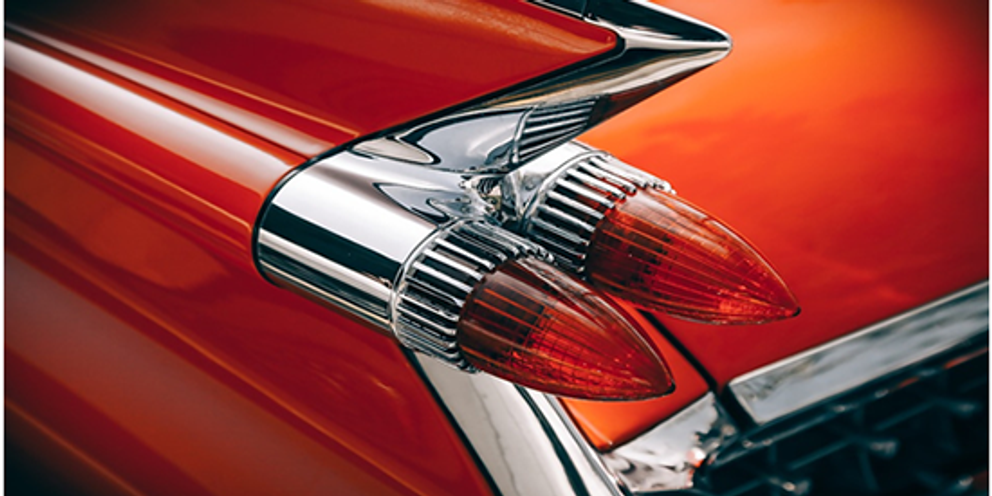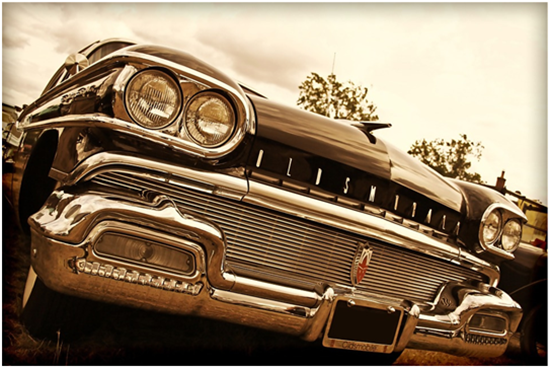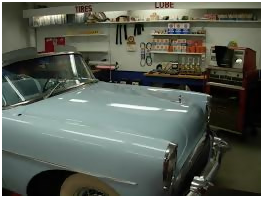
Car Protection Tips: Classic Car Storage
Writer John Linden
It is easy to get lazy and watch a piece of history fade away under the ravages of time -such is that fate of most vehicles eventually. Some cars, however, deserve a better outcome and there are those of us willing to give it to them. Whether you have restored, cared for, or purchased the car for yourself, you are unlikely unwilling to see that investment in either time or money go to waste. A few wrong steps and your classic automobile can quickly become another piece of scrap.
When insuring your classic car, there are often rules and stipulations around how such a vehicle may be stored. Many of these rules make sense as proper storage over the winter months or during more extended periods of inactivity is key to ensuring the longevity and beauty of your classic car. In many cases, your storage options will be significantly reduced. These options are usually reduced to residential garages, a separate purpose-built storage building (like a detached garage elsewhere on your property), or classic car storage facilities.
We are going to cover the significant steps you need to take when putting a car into storage, as well as some unique advice for the classic car owners out there.
Tip #1: Utilize the Proper Storage Method
While most modern vehicles can manage in an outdoor lot or covered lot, more expensive or temperamental classic cars should be put into their own storage units whenever possible. The risk of dings and scratches from the many passers-by over the possible months is enough to make one squirm. As stated before, your insurance will likely state what storage facilities are acceptable.
A personal storage unit not only avoid most of the weather and moisture issues; it also prevents unwanted attention from other people while you are away. Many specialized units made for classic cars will also have some forms of climate control. Keeping the in-room climate stable will ward away much of the deterioration that may occur to the paint, upholstery, tires and even engine. When you are taking the course of decades, these little tweaks will make all the difference in a vehicle’s life span.
Anywhere you choose should be dry and out of direct light. Sunlight will quickly fade colors and damage materials while moisture will wreak havoc on both the interior and exterior of your vehicle.
Also, make sure the area you are storing your vehicle in is of a suitable size. The last thing you want to do is risk dings and scratches while trying to protect your car.

Tip #2: Perform a Complete Cleaning and Detailing Routine
You will want to completely clean your vehicle from top to bottom to remove all dirt and grime that can lead to further damage down the road. Be exacting in your standards. You would be surprised how much a little dirt or mud can do to your vehicle over the course of months. Apply a coat of wax afterward to protect the vehicle exterior further.
Replace the oil and then circulate it through the engine for a few minutes. Doing this will remove most contaminants from your vehicle's oil. These contaminants will wear away at your car from the inside out if left unchecked. Fresh oil will also protect against corrosion during the winter months.
You will also want to grease up all grease fittings as well as door hinges and latches to avoid corrosion and rust. Lubricate everything. Make sure to spray the exposed areas of your engine. Rust on the engine block should not be left to fester. The right amount of lubricant will create a protective coating on pieces like the hose clamps and coils while you are away.
Rather than trying to drain all the fuel from your tank (a futile effort), it is instead suggested to run out as much of the fuel as possible and fill your tank up with fresh premium fuel (or whatever the highest grade your classic car will take). If you are storing your vehicle over winter, then you may want to invest in adding a fuel stabilizer. Also, ensure your coolant is of the proper mixture to avoid freezing during winter.
Cover or stuff your tailpipe and leave windows only a crack open. You want to avoid condensation buildup, but you also want to prevent rodents making a home out of your classic car. DO NOT forget that you put the tailpipe plugs in. Try adding a piece of ribbon to whatever you use to make it more visible.
A box of baking soda left on the inside can absorb any unwanted smells and avoid attracting unwanted pests. If really worried about rodents, a couple strategically placed pieces of rat poison can go a long way -just be sure to check in on it, rat corpses don’t age well.
Tip #3: Remove the Battery
You will want to ensure that your battery does not die while you are away. In the winter months, this will definitely be the end of that battery.
Battery acid leaks will do massive amounts of damage to your car’s engine. When you are away, and that acid is eating away at the engine for all those months it can be devastating. You will likely want to remove the battery and take it with you to avoid this possibility and the chance for it to die on you.
Battery maintainers can be used for keeping your battery alive during storage.
Tip #4: Use Wheel Blocks or Jack Stands
Instead of using the parking brake, you will want to utilize wheel blocks, or even better, jack stands. Wheel blocks will allow you to release the brakes which will prevent the brake pads from sticking to the rotors. Wheel blocks accomplish this while also taking the pressure off the suspension components of the vehicle. Relieving this pressure will help maintain the efficiency and effectiveness of your suspension for when your vehicle is in use.
Jack stands will also slow the natural rate of decompression in the tires. Any tire left long enough will eventually flatten out and added pressure will quicken this process. Flat-spotting is a term that refers to a tire that has been sat on too long in the same position and has taken on a more oval shape. Flat-spotting will lead to you needing a new set of tires. Relieving the weight on your tires with a jack stand will maintain more of their air pressure and their overall structural integrity during a long immobilized stay.
If neither jack stands or blocks are options, you can at least ensure that the tires are at their preferred pressure before being put into storage. The optimal pressure will give them the best fighting chance over the storage period.
Tip #5: Reduce the Effects of Nature
This was partially covered in the first tip on picking your storage option. It is worth noting again, however,that those storage areas near the ocean or in direct sunlight will do considerably more damage to your vehicle in the long run than in other regions. Even your tires will suffer damage due to UV light. Exceptional care should be taken to not only maintain a dry and dark storage space, but one that also avoids considerable winds, dust, and salt exposure. Any hint of these materials should be removed from your vehicle.

If occasional exposure to the elements is unavoidable, then you should be sure to invest in a high-quality or custom car cover. A good car cover or truck cover can help to reduce a considerable amount of environmental damage. Durable weather resistant covers and lightweight, breathable covers should be used depending on the weather forecast and humidity. You want to prevent moisture build-up more than anything.
A custom car cover made for you specific classic and climate is going to be your best option in these cases. The only time you don’t want to use a car cover is when you already have the vehicle stored in an indoor climate-controlled environment, and the cover may cause a buildup of condensation or prevent the expulsion of moisture.
Tip #6: Condition and Treat any Vinyl or Leather
Vinyl material is very prone to drying out and cracking over time. If you plan on storing your vehicle for an extended period, take the time to treat the vinyl with a vinyl conditioner or treatment. Check on the vehicle’s leather and plastic pieces as well. Leather and plastic materialscan be protected further with a silicone-based conditioner.
Make sure to vacuum up all dirt and debris before applying a cleaner to thesesurfaces. Use a soft brush to lightly scrub and spot check problem areas. You should then use a microfiber towel to wipe away down the area.
Allow up to 24-48 hours for all surfaces to dry before placing your vehicle into storage.
Tip #7: Check up on and Operate the Vehicle When Possible
Though it is likely not always going to be possible, you will want to start up and possibly drive your car around for at least a few minutes each month. Even if it is only every few months, it is still much better than nothing. This will ensure that your engine is not locking or seizing up over time and that all its parts remain lubricated and functional. The tires will also benefit greatly from getting a few rotations in.
These regular checkups will also help you stay on top of any arising issues that can become expensive or debilitating in the future. Little problems are always cheaper and easier to fix than big ones -but little problems always become big ones one day. It is the accumulation of smaller issues that usually lead to the end of a classic car’s life.
These visits also let you check up on the storage situation. A small leak and the buildup of condensation in a storage unit can be disastrous over a long period of time. Inspect the temperature, moisture and dirt buildup to see how secure the storage space is. A regular checkup is also essential for security reasons. Long abandoned storage units are more likely to be broken into.
Tip #8: Know Your Car
Keeping a classic operating smoothly is as much an art form as it is a science. Over the decades no one will get to know your vehicle as you do. Even if it is a relatively new purchase, you need to get a feel for your car. Every style of car ever made has its own unique quirks. The more you can understand the intricacies of your vehicle the more you can feel her out for possible issues and needs. Read up on forums and do the research to see what other owners of the same vehicle have discovered or problems they have overcome. These stories can serve as effective warnings or helpful advice.
Get to know other owners and trade information with them eventually You never know what you just might learn.
The truth is, other than a few items like removing the battery, most of these storage tips are the sorts of things you should be doing on a routine basis anyway to maintain your classic car properly. It all revolves around constant cleanliness, winter preparation, and engine maintenance.
Image Credits:
Updated